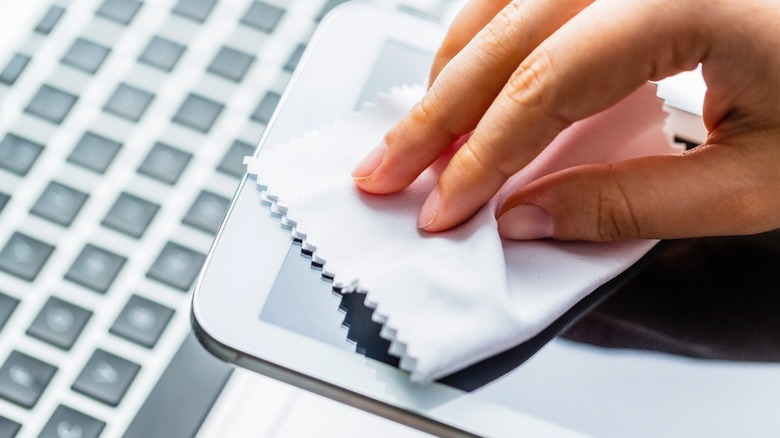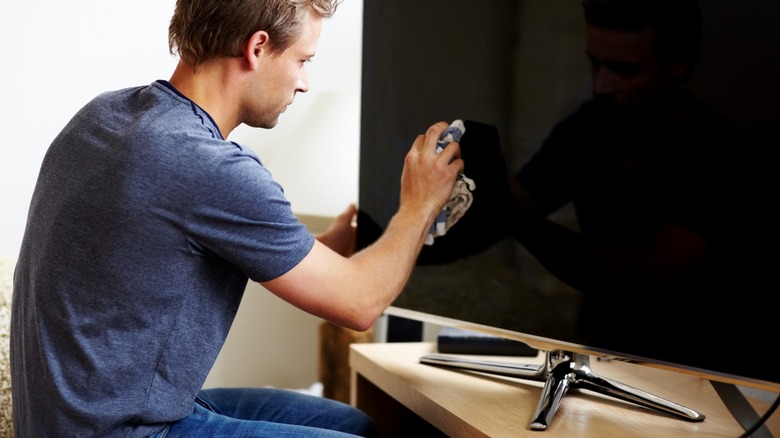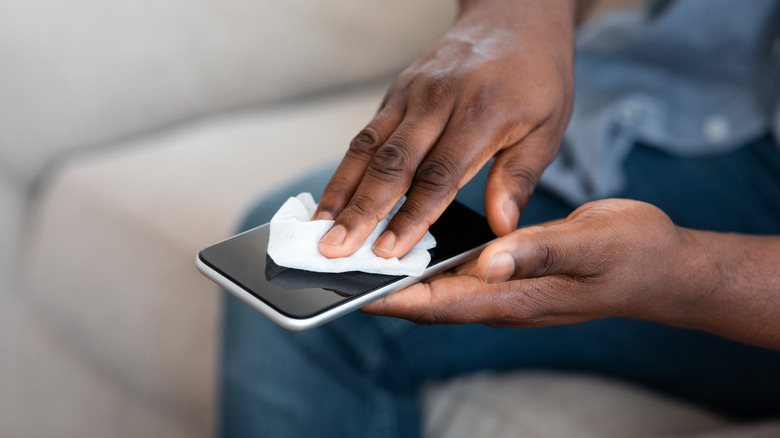The Electronics You Don't Want To Use Windex To Clean
You task your tween with weekend window cleaning by handing him a rag and a bottle of Windex. Twenty minutes later you find him squirting the neon blue cleaner on your flat-screen TV. The bittersweet parenting moment brings you to tears. Happy ones are shed seeing your child take the initiative to clean more than just the windows while sad ones fall for forgetting to tell him that electronics with screens treated with anti-glare coating, like televisions, laptops, tablets, and cellphones should never be cleaned with Windex.
It's hard to blame anyone for viewing Windex as a superhero, given its powers to do just about everything, from removing old wallpaper to loosening stuck zippers. However, the same ingredients that make Windex such a popular multipurpose cleaner are what make it harmful to use on electronic equipment, specifically ones with screens and displays featuring thin, delicate color filters.
Original Windex contains ammonia, alcohol, and other harsh chemicals designed to clean glass windows. The powerful properties can strip the anti-glare coating off screens, making them appear cloudy and foggy, and in some cases, cause permanent damage. Fortunately, most modern TVs and other electronics with screens made primarily of plastic don't require the use of commercial cleaners; rather, a simple soft cloth and a gentle touch can eliminate unsightly marks.
How to clean electronics without Windex
Prior to cleaning your flat-screen TV, computer screen, or the displays on a cellphone or tablet, it's best to consult the user's manual they came with for steps on how to safely wipe them down. Since most of the aforementioned products contain sensitive materials that can easily be scratched or marred by using Windex, a safer method to erase fingerprints or smudges is with a microfiber cloth.
To start, turn off your TV or other electronic device. It's easier to see dirt and fine blemishes when the screen is dark. Next, use a soft, lint-free cloth to gently wipe off any spots and debris. Avoid vigorously scrubbing the screen as pressing too hard will increase the likelihood of damaging the thin layer of liquid crystals in flat-panel displays. For stubborn marks, use a little distilled water to dampen the cloth and wipe in a quick circular pattern to prevent any moisture from the cloth from accumulating on the screen. To finish, use a new cloth or a dry part of the existing one to remove any residual streaks or moisture.
To avoid damaging delicate screens on electronic devices, it's important not to use paper towels, napkins, facial tissue, or cleaning pads. In addition, when dampening your cloth you can substitute distilled water with regular tap water, just be careful to spritz the water directly on the cloth and not in or near any of the devices' openings.
Tips to consider when cleaning sensitive electronics
Many homeowners use Windex to kill germs on grimy household items; however, Windex Original isn't marketed as an anti-bacterial cleaning product. This is yet another reason not to use it on sensitive electronics. If you want to safely disinfect your television or computer monitor, try applying a simple DIY cleaning solution directly to dirty fingerprints and caked-on grime. To do so, just add a single drop of mild dish soap to 1/4 cup water and mix thoroughly. Next, dip a corner of a microfiber cloth into the solution. Make sure the cloth isn't dripping wet before gently wiping it directly on the stains. Always go back over the area with a dry cloth to absorb any excess moisture as your electronics could suffer substantial damage if water seeps into the inner workings.
Finally, it's no secret harsh chemicals can ruin fragile touchscreens on cellphones, tablets, and other electronic devices. It's the reason Windex created a line of ammonia-free wipes specially designed for sensitive electronics. According to the manufacturer, the product will eliminate lint and dirty fingerprints from sensitive electronics without damaging screens. Another option to clean a grimy screen is to use disposable wipes containing 70% isopropyl alcohol or 75% ethyl alcohol. Both options have been deemed safe by Apple and Samsung for use on their electronic devices.


